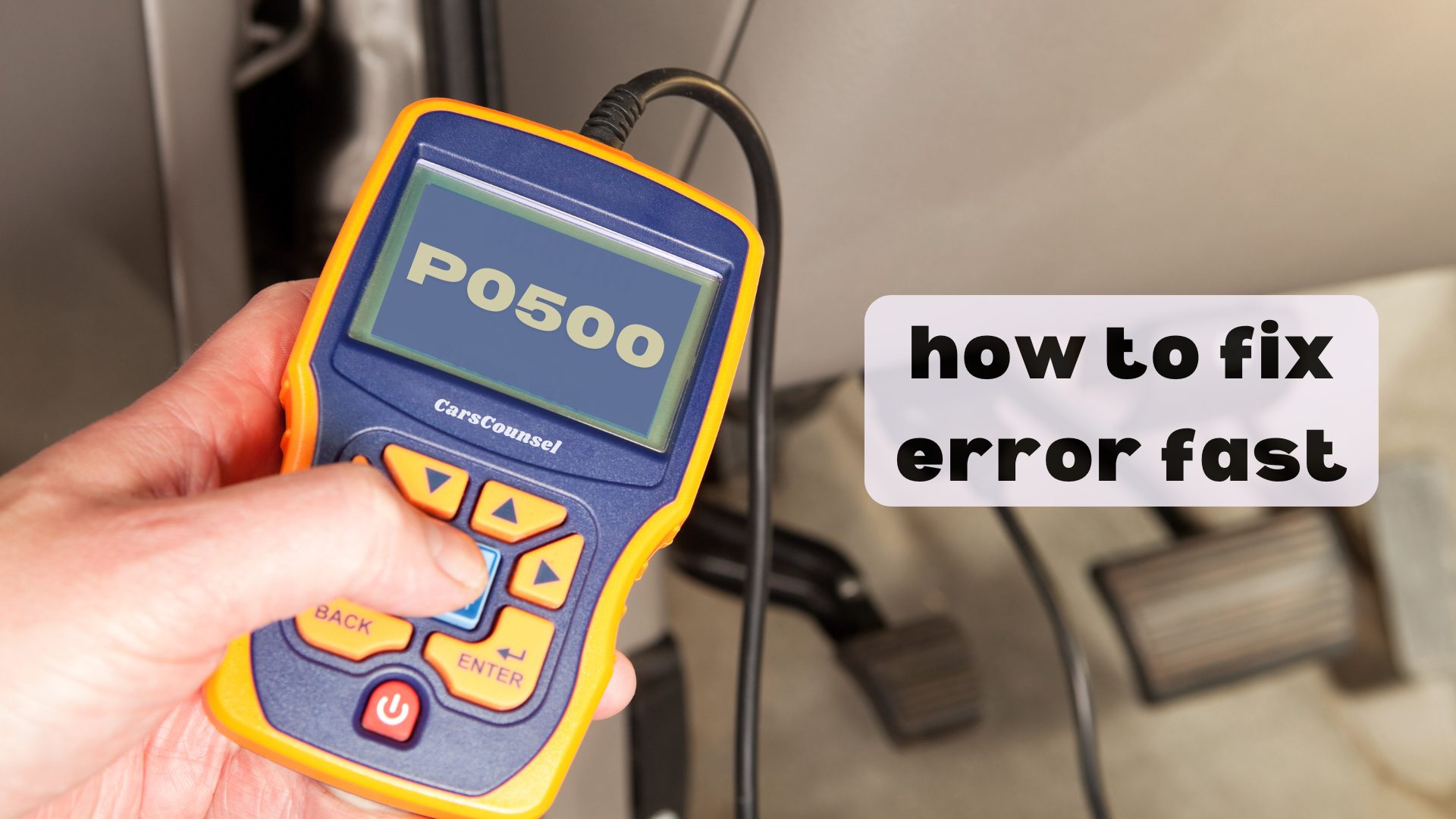When you see a P0500 code, it means there’s an issue with your car’s speed sensor, which can mess with things like ABS and transmission.
To fix it quickly, use an OBD-II scanner to check the OBD2 Codes and look at the speed sensor and its wiring for any damage or corrosion. If the sensor is bad, follow your vehicle manual to replace it.
But what if the sensor isn’t the problem? Let’s look at other common issues and solutions to make sure your car runs smoothly.

Quick Navigation
Key Takeaways
- Use a code reader to find and clear the P0500 error after figuring out what’s wrong.
- Look at the speed sensor and fix or replace it if it’s broken to get accurate speed readings.
- Check and fix any damaged or rusty wires connected to the speed sensor.
- Update the car’s computer software to make sure it talks correctly with the speed sensor.
What Is P0500 Code
The P0500 code means there’s a problem with your car’s speed sensor circuit, which is crucial for measuring and sending your speed to the Engine Control Unit (ECU).
The speed sensor keeps track of how fast you’re going and sends this information to the ECU. This data helps control things like transmission shifting, cruise control, and the anti-lock braking system (ABS).
If the speed sensor circuit isn’t working, the ECU doesn’t get accurate speed information, which can cause performance issues. Your car’s speed reading might become unreliable, affecting overall driving safety.
Fixing the P0500 code quickly ensures that your car’s systems stay in sync and work properly, keeping you safe on the road.
Common Symptoms
If your speedometer is acting up and showing the wrong speeds, it could be a sign of a P0500 code problem. This can make driving confusing.
Another sign to watch for is rough shifting, where the car jerks or hesitates when changing gears because the transmission isn’t getting the right speed info.
Your car might also stall out of nowhere because the engine control unit (ECU) can’t manage things properly without the correct speed data.
Ignoring these issues can make driving more difficult and even unsafe. It’s important to get these problems checked out and fixed quickly to keep your car running well and safely.
Potential Risks
Ignoring a P0500 code can be dangerous, affecting both your vehicle’s safety and how well it runs.
Safety issues arise because a faulty speed sensor disrupts important systems like ABS and traction control, making your car less stable in bad conditions. If the speed sensor isn’t functioning correctly, your speedometer might display the wrong speed, which could lead to accidents or receiving a ticket.
Additionally, your car might experience rough gear shifts or stalling due to the lack of accurate speed information, making driving unpredictable and unsafe.
Fixing the P0500 code promptly ensures your car runs smoothly and safely, while also helping you avoid further damage and costly repairs.
Always address such problems immediately to keep your vehicle in top shape and safe to drive.
Diagnostic Tools
An OBD-II scanner is crucial for figuring out and confirming a P0500 code in your car. This tool helps you read error codes and pinpoint issues with the speed sensor circuit.
Here’s how to use a diagnostic scanner:
- Connect the Scanner: Plug the OBD-II scanner into the car’s diagnostic port, usually found under the dashboard.
- Get Error Codes: Turn on the ignition and follow the instructions on the scanner to read the error codes.
- Check the Data: Look at the P0500 code and any other related codes that might show more problems.
- Clear Codes: After fixing the issues, use the scanner to clear the error codes and make sure the problem is fixed.
Using these scanners the right way helps you find problems accurately and make repairs efficiently.
Faulty Speed Sensor
A bad speed sensor can cause your speedometer to show incorrect readings and make your transmission behave unpredictably, so it’s important to fix it quickly. There are different types of speed sensors, like wheel speed sensors, vehicle speed sensors, and transmission speed sensors. Figuring out which one is causing the problem is key to fixing it right.
| Speed Sensor Type | Symptoms | Replacement Tips |
|---|---|---|
| Wheel Speed Sensor | ABS light on, braking issues | Make sure it’s properly aligned |
| Vehicle Speed Sensor | Erratic speedometer | Use parts from the original manufacturer |
| Transmission Speed Sensor | Harsh shifting, stalling | Check the transmission fluid |
To replace a bad sensor, first disconnect the battery. Find the sensor and remove it carefully. Put in the new sensor and make sure all connections are secure. Always check your vehicle’s manual for specific instructions.
Wiring Issues
When dealing with a faulty speed sensor, it’s important to check the wiring for any damage or corrosion that might be messing with the sensor’s signal.
Here’s what you should do:
- Look Over the Wires: Check for any frayed wires, exposed parts, or corrosion.
- Test for Continuity: Use a multimeter to see if the wires are intact and not broken.
- Check the Connectors: Make sure all connectors fit snugly and the contacts are clean.
- Measure the Voltage: Test the voltage at different points to ensure the electricity is flowing properly.
Following these steps will help you find and fix any wiring problems that might be causing the P0500 code, ensuring your speed sensor sends accurate data to the ECU.
ECU Malfunction
If the ECU is acting up, it might misread or ignore the speed sensor’s data, causing a P0500 code.
To fix this, start by testing the ECU with special diagnostic tools to check for any errors or odd behavior.
Look for software updates from your car’s manufacturer because these updates can often solve ECU problems.
Make sure the ECU’s software is up-to-date to avoid miscommunication with the speed sensor.
If testing and updates don’t solve the issue, you might need to replace the ECU. Since this component is quite complex, it’s a good idea to get professional help.
Regularly updating the ECU software and doing routine checks can help prevent future P0500 codes.
Environmental Impacts
Environmental Impacts
Exposure to extreme conditions like too much heat, moisture, or corrosive materials can seriously affect how well the speed sensor works and cause a P0500 code. Bad weather can wear down the sensor, making it not last as long and causing it to break.
To reduce these problems, consider the following:
- Protective Measures: Use covers and seals to shield the sensor from harsh conditions.
- Regular Inspections: Check often for signs of rust or damage from the environment.
- Quality Components: Buy high-quality, weather-resistant sensors to make them last longer.
- Proper Storage: When not using your vehicle, keep it in a controlled environment to avoid long exposure to bad weather.
Installation Errors
If the speed sensor isn’t installed correctly, you might see a P0500 error code, which can mess up your speed readings and cause problems with your vehicle.
It’s crucial to make sure the sensor is placed correctly to get accurate speed data. Carefully follow the installation steps in your vehicle’s manual. If the sensor isn’t lined up right or isn’t secured properly, it won’t send accurate signals to the ECU.
Make sure the sensor is firmly attached and connected to the wiring without any strain or obstacles. Don’t tighten it too much, as this can break the sensor.
Also, ensure the mounting surface is clean and clear of debris. Proper installation helps avoid P0500 errors and ensures your vehicle runs smoothly and safely.
Repair and Maintenance
Keeping your vehicle’s speed sensor in good shape ensures accurate speed readings and helps you avoid P0500 error codes. Follow these steps to keep your car running smoothly:
- Check Regularly: Look at the speed sensor and wiring often to see if they’re worn out or damaged.
- Do Preventive Maintenance: Keep the car’s electrical systems in top shape to avoid surprises.
- Test and Replace: Use diagnostic tools to check if the sensor is working and replace any bad parts right away.
- Keep Records: Write down all inspections and repairs to keep track of recurring issues and make sure everything is followed up on properly.
More OBD-II Codes
Frequently Asked Questions
Can a P0500 Code Affect My Vehicle’s ABS System?
A P0500 code can definitely mess with your car’s ABS. The ABS needs accurate speed info from sensors to work right, so if there’s a problem with those sensors, your braking system might not perform as it should.
How Does the Speed Sensor Communicate With the Ecu?
The speed sensor, which can be either a magnetic or hall-effect type, sends signals to the ECU by turning the wheel’s speed into electrical signals. The ECU then reads these signals to keep track of and control how the vehicle is performing.
Are Aftermarket Speed Sensors Reliable for Replacing OEM Parts?
Think of your car like a well-tuned orchestra. Aftermarket speed sensors can work just as well as original ones if you make sure they are good quality and compatible. Always check that the specs match the original parts to keep everything running smoothly.
What Is the Expected Lifespan of a Vehicle Speed Sensor?
A vehicle speed sensor usually lasts between 60,000 and 100,000 miles. How long it lasts can depend on how well it’s taken care of, the conditions it’s exposed to, and how the car is used. Regular maintenance can help it work better and last longer.
Can a P0500 Code Cause Issues With Cruise Control Functionality?
Yes, a P0500 code can cause problems with cruise control. This code indicates a speed sensor malfunction, which messes up accurate speed readings and stops the cruise control from keeping a steady speed.
Conclusion
You’ve now got a clear way to fix the P0500 code quickly.
Use an OBD-II scanner, check and replace the speed sensor if needed, and see if the ECU needs any updates.
Regular maintenance can help prevent future problems.
By following these steps, your car will run smoothly, avoiding bigger issues and costly repairs.
Stay on top of it, and your car will thank you.

